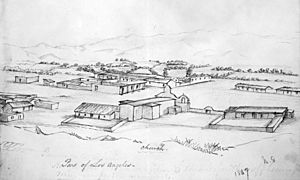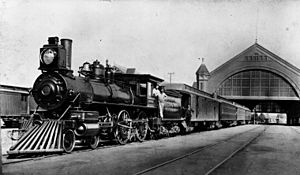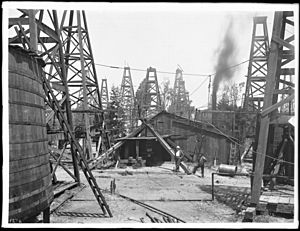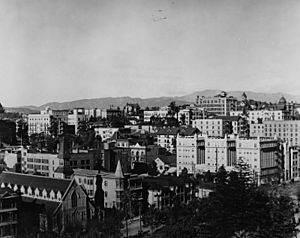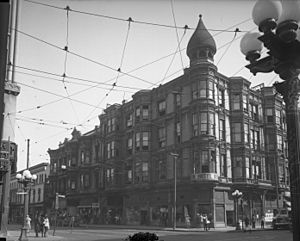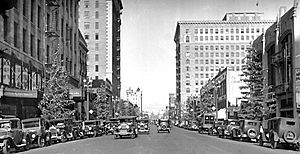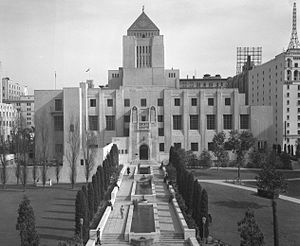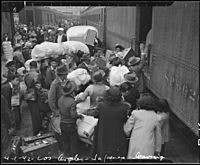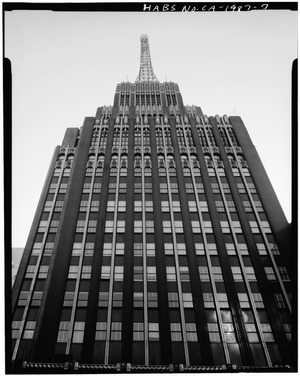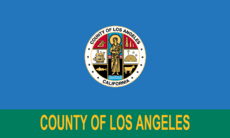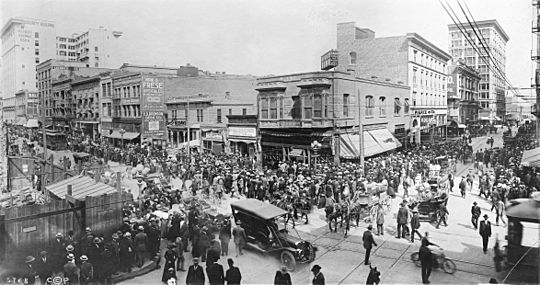History of Los Angeles facts for kids
The history of Los Angeles began in 1781 when 44 settlers from New Spain established a permanent settlement in what is now Downtown Los Angeles, as instructed by Spanish Governor of Las Californias, Felipe de Neve, and authorized by Viceroy Antonio María de Bucareli. After sovereignty changed from Mexico to the United States in 1848, great changes came from the completion of the Santa Fe railroad line from Chicago to Los Angeles in 1885. “Overlanders” flooded in, mostly white Protestants from the Lower Midwest and South.
Los Angeles had a strong economic base in farming, oil, tourism, real estate and movies. It grew rapidly with many suburban areas inside and outside the city limits. Its motion picture industry made the city world-famous, and World War II brought new industry, especially high-tech aircraft construction. Politically the city was moderately conservative, with a weak labor union sector.
Since the 1960s, growth has slowed—and traffic delays have become infamous. Los Angeles was a pioneer in freeway development as the public transit system deteriorated. New arrivals, especially from Mexico and Asia, have transformed the demographic base since the 1960s. Old industries have declined, including farming, oil, military and aircraft, but tourism, entertainment and high-tech remain strong. Over time, droughts and wildfires have increased in frequency and become less seasonal and more year-round, further straining the city's water security.
Contents
Early history
By 3000 B.C. the area was occupied by the Hokan-speaking people of the Milling Stone Period who fished, hunted sea mammals, and gathered wild seeds. They were later replaced by migrants — possibly fleeing drought in the Great Basin — who spoke a Uto-Aztecan language called Tongva. The Tongva people called the Los Angeles region Yaa in Tongva.
By the time of the arrival of the Spanish in the 18th century A.D., there were 250,000 to 300,000 native people in California and 5,000 in the Los Angeles basin. Since contact with Europeans, the people in what became Los Angeles were known as Gabrielinos and Fernandeños, after the missions associated with them.
The land occupied and used by the Gabrielinos covered about four thousand square miles. It included the enormous floodplain drained by the Los Angeles and San Gabriel rivers and the southern Channel Islands, including the Santa Barbara, San Clemente, Santa Catalina, and San Nicholas Islands. They were part of a sophisticated group of trading partners that included the Chumash to the west, the Cahuilla and Mojave to the east, and the Juaneños and Luiseños to the south. Their trade extended to the Colorado River and included slavery.
The lives of the Gabrielinos were governed by a set of religious and cultural practices that included belief in creative supernatural forces. They worshipped a creator god, Chinigchinix, and a female virgin god, Chukit. Their Great Morning Ceremony was based on a belief in the afterlife. Their language was called Kizh or Kij, and they practiced cremation.
Generations before the arrival of the Europeans, the Gabrielinos had identified and lived in the best sites for human occupation. The survival and success of Los Angeles would depend greatly on the presence of a nearby and prosperous Gabrielino village called Yaanga. Its residents would provide the colonists with seafood, fish, bowls, pelts, and baskets. For pay, they would dig ditches, haul water, and provide domestic help. They often intermarried with the Mexican colonists.
Spanish era 1769–1821
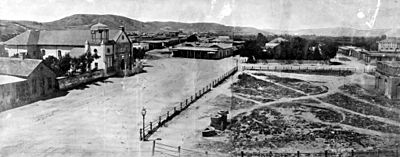
In 1542 and 1602 the first Europeans to visit the region were Captain Juan Rodriguez Cabrillo and Captain Sebastián Vizcaíno. It would be another 166 years before another European would visit the region.
Plans for the pueblo
The one person most responsible for the founding of Los Angeles was the new Governor of California, Felipe de Neve.
In 1777 Neve toured Alta California and decided to establish civic pueblos for the support of the military presidios. The new pueblos would reduce the secular power of the missions by reducing the dependency of the military on them. At the same time, they would promote the development of industry and agriculture.
Neve identified Santa Barbara, San Jose, and Los Angeles as sites for his new pueblos. His plans for them closely followed a set of Spanish city-planning laws contained in the Laws of the Indies promulgated by King Philip II in 1573. Those laws were responsible for laying the foundations of the largest cities in the region, including Los Angeles, San Francisco, Tucson, and San Antonio—as well as Sonoma, Monterey, Santa Fe, San Jose, and Laredo.
The Spanish system called for an open central plaza, surrounded by a fortified church, administrative buildings, and streets laid out in a grid, defining rectangles of limited size to be used for farming (suertes) and residences (solares).
It was in accordance with such precise planning—specified in the Law of the Indies—that Governor Neve founded the pueblo of San Jose de Guadalupe, California's first municipality, on the great plain of Santa Clara on 29 November 1777.
Pobladores
The Los Angeles Pobladores ("townspeople") is the name given to the 44 original settlers, 22 adults and 22 children from Sonora, who founded the town.
In December, 1777 Viceroy Antonio María de Bucareli y Ursúa and Commandant General Teodoro de Croix gave approval for the founding of a civic municipality at Los Angeles and a new presidio at Santa Barbara. Croix put the California lieutenant governor Fernando Rivera y Moncada in charge of recruiting colonists for the new settlements. He was originally instructed to recruit 55 soldiers, 22 settlers with families and 1,000 head of livestock that included horses for the military. After an exhausting search that took him to Mazatlán, Rosario, and Durango, Rivera y Moncada only recruited 12 settlers and 45 soldiers. Like the people of most towns in New Spain, they were a mix of Indian and Spanish backgrounds. The Quechan Revolt killed 95 settlers and soldiers, including Rivera y Moncada. In his Reglamento, the newly baptized Indians were no longer to reside in the mission but live in their traditional rancherías (villages). Neve's new plans for the Indians' role in his new town drew instant disapproval from the mission priests.
Zúñiga's party arrived at the mission on 18 July 1781. Because they had arrived with smallpox, they were immediately quarantined a short distance away from the mission. Members of the other party would arrive at different times by August. They made their way to Los Angeles and probably received their land before September.
Founding
The official date for the founding of the city is September 4, 1781. The families had arrived from Mexico earlier in 1781, in two groups, and some of them had most likely been working on their assigned plots of land since the early summer.
The name first given to the settlement is debated. Historian Doyce P. Nunis has said that the Spanish named it "El Pueblo de la Reyna de los Angeles" ("The Town of the Queen of the Angels"). For proof, he pointed to a map dated 1785, where that phrase was used. Frank Weber, the diocesan archivist, replied, however, that the name given by the founders was "El Pueblo de Nuestra Señora de los Angeles de Porciuncula", or "the town of Our Lady of the Angels of Porciuncula." and that the map was in error.
Early pueblo
The town grew as soldiers and other settlers came into town and stayed. In 1784 a chapel was built on the Plaza. The pobladores were given title to their land two years later. By 1800, there were 29 buildings that surrounded the Plaza, flat-roofed, one-story adobe buildings with thatched roofs made of tule. By 1821 Los Angeles had grown into a self-sustaining farming community, the largest in Southern California.
Each settler received four rectangles of land, suertes, for farming, two irrigated plots and two dry ones. When the settlers arrived, the Los Angeles floodplain was heavily wooded with willows and oaks. The Los Angeles river flowed all year. Wildlife was plentiful, including deer, antelope, and black bears, even an occasional grizzly bear. There were abundant wetlands and swamps. Steelhead and salmon swam the rivers.
The first settlers built a water system consisting of ditches (zanjas) leading from the river through the middle of town and into the farmlands. Indians were employed to haul fresh drinking water from a special pool farther upstream. The city was first known as a producer of fine wine grapes. The raising of cattle and the commerce in tallow and hides would come later.
Because of the great economic potential for Los Angeles, the demand for Indian labor grew rapidly. Yaanga began attracting Indians from the islands and as far away as San Diego and San Luis Obispo. The village began to look like a refugee camp. Unlike the missions, the pobladores paid Indians for their labor. In exchange for their work as farm workers, vaqueros, ditch diggers, water haulers, and domestic help; they were paid in clothing and other goods as well as cash and alcohol. The pobladores bartered with them for prized sea-otter and seal pelts, sieves, trays, baskets, mats, and other woven goods. This commerce greatly contributed to the economic success of the town and the attraction of other Indians to the city.
During the 1780s, San Gabriel Mission became the object of an Indian revolt. The mission had expropriated all the suitable farming land; the Indians found themselves abused and forced to work on lands that they once owned. A young Indian healer, Toypurina began touring the area, preaching against the injustices suffered by her people. She won over four rancherías and led them in an attack on the mission at San Gabriel. The soldiers were able to defend the mission, and arrested 17, including Toypurina.
In 1787 Governor Pedro Fages drew up his "Instructions for the Corporal Guard of the Pueblo of Los Angeles." The Instructions included rules for employing Indians, not using corporal punishment, and protecting the Indian rancherías. As a result, Indians found themselves with more freedom to choose between the benefits of the missions and the pueblo-associated rancherías.
In 1795, Sergeant Pablo Cota led an expedition from the Simi Valley through the Conejo-Calabasas region and into the San Fernando Valley. His party visited the rancho of Francisco Reyes. They found the local Indians hard at work as vaqueros and caring for crops. Padre Vincente de Santa Maria was traveling with the party and made these observations:
All of pagandom (Indians) is fond of the pueblo of Los Angeles, of the rancho of Reyes, and of the ditches (water system). Here we see nothing but pagans, clad in shoes, with sombreros and blankets, and serving as muleteers to the settlers and rancheros, so that if it were not for the gentiles there would be neither pueblos nor ranches. These pagan Indians care neither for the missions nor for the missionaries.
Not only economic ties but also marriage drew many Indians into the life of the pueblo. In 1784—only three years after the founding—the first recorded marriages in Los Angeles took place. The two sons of settler Basilio Rosas, Maximo and José Carlos, married two young Indian women, María Antonia and María Dolores.
The construction on the Plaza of La Iglesia de Nuestra Señora de Los Ángeles took place between 1818 and 1822, much of it with Indian labor. The new church completed Governor Neve's planned transition of authority from mission to pueblo. The angelinos would no longer have to make the bumpy 11-mile (18 km) ride to Sunday Mass at Mission San Gabriel. In 1820 the route of El Camino Viejo was established from Los Angeles, over the mountains to the north and up the west side of the San Joaquin Valley to the east side of San Francisco Bay.
Mexican Era, 1821–1848
Mexico's independence from Spain in 1821 was celebrated with great festivity throughout Alta California. No longer subjects of the king, people were now ciudadanos, citizens with rights under the law. In the plazas of Monterey, Santa Barbara, Los Angeles, and other settlements, people swore allegiance to the new government, the Spanish flag was lowered, and the flag of independent Mexico raised.
Independence brought other advantages, including economic growth. There was a corresponding increase in population as more Indians were assimilated and others arrived from America, Europe, and other parts of Mexico. Before 1820, there were just 650 people in the pueblo. By 1841, the population nearly tripled to 1,680.
Secularization of the missions
During the rest of the 1820s the agriculture and cattle ranching expanded, as did the trade in hides and tallow. The new church was completed, and the political life of the city developed. Los Angeles was separated from Santa Barbara administration. The system of ditches which provided water from the river was rebuilt. Trade and commerce further increased with the secularization of the California missions by the Mexican Congress in 1833. Extensive mission lands suddenly became available to government officials, ranchers, and land speculators. The governor made more than 800 land grants during this period, including a grant of over 33,000-acres in 1839 to Francisco Sepulveda which was later developed as the westside of Los Angeles.
Much of this progress, however, bypassed the Indians of the traditional villages who were not assimilated into the mestizo culture. Being regarded as minors who could not think for themselves, they were increasingly marginalized and relieved of their land titles, often by being drawn into debt.
In 1834, Governor Pico was married to Maria Ignacio Alvarado in the Plaza church. It was attended by the entire population of the pueblo, 800 people, plus hundreds from elsewhere in Alta California. In 1835, the Mexican Congress declared Los Angeles a city, making it the official capital of Alta California. It was now the region's leading city.
The same period also saw the arrival of many foreigners from the United States and Europe. They would play a pivotal role in the U.S. takeover. Early California settler John Bidwell included several historical figures in his recollection of people he knew in March, 1845.
It then had probably two hundred and fifty people, of whom I recall Don Abel Stearns, John Temple, Captain Alexander Bell, William Wolfskill, Lemuel Carpenter, David W. Alexander; also of Mexicans, Pio Pico (governor), Don Juan Bandini, and others.
Upon arriving in Los Angeles in 1831, Jean-Louis Vignes bought 104 acres (0.42 km2) of land located between the original Pueblo and the banks of the Los Angeles River. He planted a vineyard and prepared to make wine. He named his property El Aliso after the centuries-old tree found near the entrance. The grapes available at the time, of the Mission variety, were brought to Alta California by the Franciscan Brothers at the end of the 18th century. They grew well and yielded large quantities of wine, but Jean-Louis Vignes was not satisfied with the results. Therefore, he decided to import better vines from Bordeaux: Cabernet Sauvignon, Cabernet Franc, and Sauvignon blanc. In 1840, Jean-Louis Vignes made the first recorded shipment of California wine. The Los Angeles market was too small for his production, and he loaded a shipment on the Monsoon, bound for Northern California. By 1842, he made regular shipments to Santa Barbara, Monterey and San Francisco. By 1849, El Aliso, was the most extensive vineyard in California. Vignes owned over 40,000 vines and produced 150,000 bottles, or 1,000 barrels, per year.
May, 1846
In May, 1846, the Mexican–American War broke out. Because of Mexico's inability to defend its northern territories, California was exposed to invasion. On August 13, 1846, Commodore Robert F. Stockton , accompanied by John C. Frémont, seized the town; Governor Pico had fled to Mexico. After three weeks of occupation, Stockton left, leaving Lieutenant Archibald H. Gillespie in charge. Subsequent maltreatment by Gillespie and his troops caused a local force of 300 locals to force the Americans to leave, ending the first phase of the Battle of Los Angeles. Further small skirmishes took place. Stockton regrouped in San Diego and marched north with six hundred troops while Frémont marched south from Monterey with 400 troops. After a few skirmishes outside the city, the two forces entered Los Angeles, this time without bloodshed. Andrés Pico was in charge; he signed the so-called Treaty of Cahuenga (it was not a treaty) on 13 January 1847, ending the California phase of the Mexican–American War. The Treaty of Guadalupe Hidalgo, signed on 2 February 1848, ended the war and ceded California to the U.S.
Transitional era, 1848–1870
According to historian Mary P. Ryan, "The U.S. army swept into California with the surveyor as well as the sword and quickly translated Spanish and Mexican practices into cartographic representations." Under colonial law, land held by grantees was not disposable. It reverted to the government. It was determined that under U.S. property law, lands owned by the city were disposable. Also, the diseños (property sketches) held by residents did not secure title in an American court.
California's new military governor Bennett C. Riley ruled that land could not be sold that was not on a city map. In 1849, Lieutenant Edward Ord surveyed Los Angeles to confirm and extend the streets of the city. His survey put the city into the real-estate business, creating its first real-estate boom and filling its treasury. Street names were changed from Spanish to English. Further surveys and street plans replaced the original plan for the pueblo with a new civic center south of the Plaza and a new use of space.
The fragmentation of Los Angeles real estate on the Anglo-Mexican axis had begun. Under the Spanish system, the residences of the power-elite clustered around the Plaza in the center of town. In the new American system, the power elite would reside in the outskirts. The emerging minorities, including the Chinese, Italians, French, and Russians, joined with the Mexicans near the Plaza.
In 1848, the gold discovered in Coloma first brought thousands of miners from Sonora in northern Mexico on the way to the gold fields. So many of them settled in the area north of the Plaza that it came to be known as Sonoratown.
During the Gold Rush years in northern California, Los Angeles became known as the "Queen of the Cow Counties" for its role in supplying beef and other foodstuffs to hungry miners in the north. Among the cow counties, Los Angeles County had the largest herds in the state followed closely by Santa Barbara and Monterey Counties.
With the temporary absence of a legal system, the city was quickly submerged in lawlessness.
Some of the residents resisted the new Anglo powers by resorting to banditry against the gringos. In 1856, Juan Flores threatened Southern California with a full-scale revolt. He was hanged in Los Angeles. Tiburcio Vasquez, a legend in his own time among the Mexican-born population for his daring feats against the Anglos, was captured in present-day Santa Clarita, California on May 14, 1874. He was hanged in 1875.
The fear of Mexican violence and the racially motivated violence inflicted on them further marginalized the Mexicans, greatly reducing their economic and political opportunities.
John Gately Downey, the seventh Governor of California was sworn into office on January 14, 1860, thereby becoming the first Governor from Southern California. Governor Downey was born and raised in Castlesampson, County Roscommon, Ireland, and came to Los Angeles in 1850. He was responsible for keeping California in the Union during the Civil War.
Plight of the Indians
In 1836, the Indian village of Yaanga was relocated near the future corner of Commercial and Alameda Streets. In 1845, it was relocated again to present-day Boyle Heights. With the coming of the Americans, disease took a great toll among Indians. Between 1848 and 1880, the total population of Los Angeles went from 75,050 to 12,500. Self-employed Indians were not allowed to sleep over in the city. They faced increasing competition for jobs as more Mexicans moved into the area and took over the labor force. Those who loitered or were unemployed were arrested and auctioned off as laborers to those who paid their fines. They were often paid for work with liquor, which only increased their problems.
Los Angeles was incorporated as an American city on April 4, 1850. Five months later, California was admitted into the Union. Although the Treaty of Guadalupe Hidalgo required the U.S. to grant citizenship to the Indians of former Mexican territories, the U.S. did not get around to doing that for another 80 years. The Constitution of California deprived Indians of any protection under the law, considering them as non-persons. As a result, it was impossible to bring an Anglo to trial for killing an Indian or forcing them off their property. Anglos concluded that the "quickest and best way to get rid of (their) troublesome presence was to kill them off, (and) this procedure was adopted as a standard for many years."
When New England author and Indian-rights activist Helen Hunt Jackson toured the Indian villages of Southern California in 1883, she was appalled by the racism of the Anglos living there. She wrote that they treated Indians worse than animals, hunted them for sport, robbed them of their farmlands, and brought them to the edge of extermination. While Indians were depicted by whites as lazy and shiftless, she found most of them to be hard-working craftsmen and farmers. Jackson's tour inspired her to write her 1884 novel, Ramona, which she hoped would give a human face to the atrocities and indignities suffered by the Indians in California. And it did. The novel was enormously successful, inspiring four movies and a yearly pageant in Hemet, California. Many of the Indian villages of Southern California survived because of her efforts, including Morongo, Cahuilla, Soboba, Temecula, Pechanga, and Warner Hot Springs.
Remarkably, the Gabrielino Indians, now called Tongva, also survived. in 2006, the Los Angeles Times reported that there were 2,000 of them still living in Southern California. Some were organizing to protect burial and cultural sites. Others were trying to win federal recognition as a tribe to operate a casino. The city's first newspaper, Star of Los Angeles, was a bilingual publication which began its run in 1851.
Industrial expansion and growth, 1870—1913
In the 1870s, Los Angeles was still little more than a village of 5,000. By 1900, there were over 100,000 occupants of the city. Several men actively promoted Los Angeles, working to develop it into a great city and to make themselves rich. Angelenos set out to remake their geography to challenge San Francisco with its port facilities, railway terminal, banks and factories. The Farmers and Merchants Bank of Los Angeles was the first incorporated bank in Los Angeles, founded in 1871 by John G. Downey and Isaias W. Hellman. Wealthy easterners who came as tourists recognized the growth opportunities and invested heavily in the region.
Much of Los Angeles County was farmland, with an emphasis on cattle, dairy products, vegetables and citrus fruits. After 1945 most of the farmland was converted into housing tracts.
Railroads
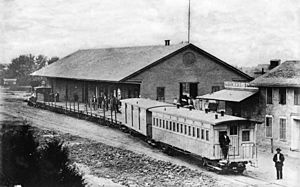
The city's first railroad, the Los Angeles & San Pedro Railroad, was inaugurated in October, 1869 by John G. Downey and Phineas Banning. It ran 21 miles (34 km) between San Pedro and Los Angeles.
The town continued to grow at a moderate pace. Railroads finally arrived to connect with the Central Pacific and San Francisco in 1876. The impact was small. Much greater was the impact of the Santa Fe system (through its subsidiary California Southern Railroad) in 1885. The Santa Fe and Southern Pacific lines provided direct connections to the East, competed vigorously for business with much lower rates, and stimulated economic growth. Tourists poured in by the thousands every week, and many planned on returning or resettling.
The city still lacked a modern harbor. Phineas Banning excavated a channel out of the mud flats of San Pedro Bay leading to Wilmington in 1871. Banning had already laid track and shipped in locomotives to connect the port to the city. Harrison Gray Otis, founder and owner of the Los Angeles Times, and a number of business colleagues embarked on reshaping southern California by expanding that into a harbor at San Pedro using federal dollars.
This put them at loggerheads with Collis P. Huntington, president of the Southern Pacific Railroad Company and one of California's "Big Four" investors in the Central Pacific and Southern Pacific. (The "Big Four" are sometimes numbered among the "robber barons" of the Gilded Age). The line reached Los Angeles in 1876 and Huntington directed it to a port at Santa Monica, where the Long Wharf was built.
April 1872, John G. Downey went to San Francisco and was successful in representing Los Angeles in discussions with Collis Huntington concerning Los Angeles's efforts to bring the Southern Pacific Railroad through Los Angeles.
In 1876 the Newhall railroad tunnel located 27 miles (43 km) north of Los Angeles between the town of San Fernando and Lyons Station Stagecoach Stop (now Newhall) was completed, providing the final link from San Francisco to Los Angeles for the railroad. The 6,940-foot-long railroad tunnel (2,115.3 m) took a year and a half to complete. Over 1500 mostly Chinese laborers took part in the tunnel construction which began at the south end of the mountain on March 22, 1875. Many of them had prior experience working on Southern Pacific's located tunnels in the Tehachapi Pass. Due to the sandstone composition of the mountain that was saturated with water and oil, frequent cave-ins occurred and the bore had to be constantly shored up by timbers during excavation. The initial location for the north end of the tunnel near Newhall was abandoned due to frequent cave-ins caused by oil soaked rock. The north end of the tunnel excavation commenced in June 1875. Water was a constant problem during construction and pumps were utilized to keep the tunnel from flooding. Workers digging from both the north and south ends of the tunnel came face to face on July 14, 1876. The bores from each end were only a half inch out of line with dimensions of 22 feet (6.7 m) high, 16.5 feet (5.0 m) wide at the bottom and over 18 feet (5.5 m) at the shoulders. Track was laid in place soon after the tunnel dig was completed and the first train passed through on August 12, 1876. On September 4 Charles Crocker notified Southern Pacific that the track had been completed on the route between San Francisco and Los Angeles.
The San Pedro forces eventually prevailed (though it required Banning and Downey to turn their railroad over to the Southern Pacific). Work on the San Pedro breakwater began in 1899 and was finished in 1910. Otis Chandler and his allies secured a change in state law in 1909 that allowed Los Angeles to absorb San Pedro and Wilmington, using a long, narrow corridor of land to connect them with the rest of the city. The debacle of the future Los Angeles harbor was termed the Free Harbor Fight.
In 1898, Henry Huntington and a San Francisco syndicate led by Isaias W. Hellman purchased five trolley lines, consolidated them into the Los Angeles Railway (the 'yellow cars') and two years later founded the Pacific Electric Railway (the 'red cars'). Los Angeles Railway served the city and the Pacific Electric Railway served the rest of the county. At its peak, the Pacific Electric was the largest electrically operated interurban railway in the world. Over 1,000 miles (1,600 km) of tracks connected Los Angeles with Hollywood, Pasadena, San Pedro, Venice Beach, Santa Monica, Pomona, San Bernardino, Long Beach, Santa Ana, Huntington Beach, and other points and was recognized as best public transportation system in the world.
Oil discovery
Oil was discovered by Edward L. Doheny in 1892, near the present location of Dodger Stadium. The Los Angeles City Oil Field was the first of many fields in the basin to be exploited, and in 1900 and 1902, respectively, the Beverly Hills Oil Field and Salt Lake Oil Field were discovered just a few miles west of the original find. Los Angeles became a center of oil production in the early 20th century, and by 1923 the region was producing one-quarter of the world's total supply; it is still a significant producer, with the Wilmington Oil Field having the fourth-largest reserves of any field in California.
Activists on the left
The immigrants arriving in the city to find jobs sometimes brought the revolutionary zeal and idealism of their homelands. These included anarchists such as Russian Emma Goldman and Ricardo Flores Magón and his brother Enrique of the Partido Liberal Mexicano. They were later joined by the socialist candidate for mayor Job Harriman, Chinese revolutionaries, the novelist Upton Sinclair, "Wobblies" (members of the Industrial Workers of the World, the IWW), and Socialist and Communist labor organizers such as the Japanese-American Karl Yoneda and the Russian-born New Yorker Meyer Baylin. The Socialists were the first to set up a soapbox in the Plaza, which would serve as the location of union rallies and protests and riots as the police attempted to break up meetings.
Class conflict
At the same time that the L.A. Times was whipping up enthusiasm for the expansion of Los Angeles it was also trying to turn it into a union-free or open shop town. Fruit growers and local merchants who had opposed the Pullman strike in 1894 subsequently formed the Merchants and Manufacturers Association (M & M) to support the L.A. Times anti-union campaign.
The California labor movement, with its strength concentrated in San Francisco, had largely ignored Los Angeles for years. It changed, in 1907, however, when the American Federation of Labor decided to challenge the open shop of "Otis Town."
In 1909, the city fathers placed a ban on free speech from public streets and private property except for the Plaza. Locals had claimed that it had been an Open Forum forever. The area was of particular concern to the owners of the L.A. Times, Harrison Grey Otis and his son-in-law Harry Chandler.
This conflict came to a head with the bombing of the Times in 1910. Two months later, the Llewellyin Iron Works near the plaza was bombed. A meeting was hastily called of the Chamber of Commerce and Manufacturers Association. The L.A. Times wrote: "radical and practical matters (were) considered, and steps taken for the adaption of such as are adequate to cope with a situation tardily recognized as the gravest that Los Angeles has ever been called upon to face."
The authorities indicted John and James McNamara, both associated with the Iron Workers Union, for the bombing; Clarence Darrow, famed Chicago defense lawyer, represented them.
At the same time the McNamara brothers were awaiting trial, Los Angeles was preparing for a city election. Job Harriman, running on the socialist ticket, was challenging the establishment's candidate.
Harriman's campaign, however, was tied to the asserted innocence of the McNamaras. But the defense was in trouble: the prosecution not only had evidence of the McNamaras' complicity, but had trapped Darrow in a clumsy attempt to bribe one of the jurors. On December 1, 1911, four days before the final election, the McNamaras entered a plea of guilty in return for prison terms. Harriman lost badly.
On Christmas Day, 1913, police attempted to break up an IWW rally of 500 taking place in the Plaza. Encountering resistance, the police waded into the crowd attacking them with their clubs. One citizen was killed. In the aftermath, the authorities attempted to impose martial law in the wake of growing protests. Seventy-three people were arrested in connection with the riots. The City Council introduced new measures to control public speaking. The Times scapegoated all foreign elements even calling onlookers and taco venders as "cultural subversives."
The open shop campaign continued from strength to strength, although not without meeting opposition from workers. By 1923, the Industrial Workers of the World had made considerable progress in organizing the longshoremen in San Pedro and led approximately 3,000 men to walk off the job. With the support of the L.A. Times, a special "Red Squad" was formed within the Los Angeles Police Department and arrested so many strikers that the city's jails were soon filled.
Some 1,200 dock workers were corralled in a special stockade in Griffith Park. The L.A. Times wrote approvingly that "stockades and forced labor were a good remedy for IWW terrorism." Public meetings were outlawed in San Pedro, Upton Sinclair was arrested at Liberty Hill in San Pedro for reading the United States Bill of Rights on the private property of a strike supporter (the arresting officer told him "we'll have none of 'that Constitution stuff'") and blanket arrests were made at union gatherings. The strike ended after members of the Ku Klux Klan and the American Legion raided the IWW Hall and attacked the men, women and children meeting there. The strike was defeated.
Los Angeles developed another industry in the early 20th century when movie producers from the East Coast relocated there. These new employers were likewise afraid of unions and other social movements: during Upton Sinclair's campaign for Governor of California under the banner of his "End Poverty In California" (EPIC) movement, Louis B. Mayer turned MGM's Culver City studio into the unofficial headquarters of the organized campaign against EPIC. MGM produced fake newsreel interviews with whiskered actors with Russian accents voicing their enthusiasm for EPIC, along with footage focusing on central casting hobos huddled on the borders of California waiting to enter and live off the bounty of its taxpayers once Sinclair was elected. Sinclair lost.
Los Angeles also acquired another industry in the years just before World War II: the garment industry. At first devoted to regional merchandise such as sportswear, the industry eventually grew to be the second largest center of garment production in the United States.
Unions began to make progress in organizing these workers as the New Deal arrived in the 1930s. An influential strike was the Los Angeles Garment Workers Strike of 1933, one of the first strikes in which Mexican immigrant workers played a prominent role for union recognition. The unions made even greater gains in the war years, as Los Angeles grew further.
Today, the ethnic makeup of the city and the politically progressive views of surrounding West Hollywood and Hollywood have made Los Angeles a strong union town. However, many garment workers in central LA, most of whom are Mexican immigrants, still work in sweat shop conditions.
Battle of the Los Angeles River
The Los Angeles River flowed clear and fresh all year, supporting 45 Gabrielino villages in the area. The source of the river was the aquifer under the San Fernando Valley, supplied with water from the surrounding mountains. The rising of the underground bedrock at the Glendale Narrows (near today's Griffith Park) squeezed the water to the surface at that point. Then, through much of the year, the river emerged from the valley to flow across the floodplain 20 miles (32 km) to the sea. The area also provided other streams, lakes, and artesian wells.
Early settlers were more than a little discouraged by the region's diverse and unpredictable weather. They watched helplessly as long droughts weakened and starved their livestock, only to be drowned and carried off by ferocious storms. During the years of little rain, people would build too close to the riverbed, only to see their homes and barns later swept out to sea during a flood. The location of the Los Angeles Plaza had to be moved twice because of previously having been built too close to the riverbed.
Worse, floods would change the river's course. When the settlers arrived, the river joined Ballona Creek to discharge in Santa Monica Bay. A fierce storm in 1835 diverted its course to Long Beach, where it stays today.
Early citizens could not even maintain a footbridge over the river from one side of the city to the other. After the American takeover, the city council authorized spending of $20,000 for a contractor to build a substantial wooden bridge across the river. The first storm to come along dislodged the bridge, used it as a battering ram to break through the embankment, and scattered its timbers all the way to the sea.
Some of the most concentrated rainfall in the history of the United States has occurred in the San Gabriel Mountains north of Los Angeles and Orange Counties. On April 5, 1926, a rain gauge in the San Gabriels collected one inch in one minute. In January, 1969, more water fell on the San Gabriels in nine days than New York City sees in a year. In February 1978, almost a foot of rain fell in 24 hours, and, in one blast, an inch and a half in five minutes. This storm caused massive debris flows throughout the region.
The greatest daily rainfall recorded in California was 26.12 inches on January 23, 1943 at Hoegees near Mt. Wilson in the San Gabriel Mountains. Fifteen other stations reported over 20 inches in two days from the same storm. Forty-five others reported 70 percent of the average annual rainfall in two days.
Quibbling between city and county governments delayed any response to the flooding until a massive storm in 1938 flooded Los Angeles and Orange Counties. The federal government stepped in. To transfer floodwater to the sea as quickly as possible, the Army Corps of Engineers paved the beds of the river and its tributaries. The Corps also built several dams and catchment basins in the canyons along the San Gabriel Mountains to reduce the debris flows. It was an enormous project, taking years to complete.
Today, the Los Angeles River functions mainly as a flood control. A drop of rain falling in the San Gabriel Mountains will reach the sea faster than an auto can drive. During today's rainstorms, the volume of the Los Angeles River at Long Beach can be as large as the Mississippi River at St. Louis.
The drilling of wells and pumping of water from the San Fernando Valley aquifer dried up the river by the 1920s. By 1980, the aquifer was supplying drinking water for 800,000 people. In that year, it was discovered that the aquifer had been contaminated. Many wells were shut down.
Water from a distance
For its first 120 years, the Los Angeles River supplied the town with ample water for homes and farms. It was estimated that the annual flow could have support a town of 250,000 people—if the water had been managed right. But Angelinos were among the most profligate users of water in the world. In the semi-arid climate, they were forever watering their lawns, gardens, orchards, and vineyards. Later on, they would need more to support the growth of commerce and manufacturing. By the beginning of the 20th century, the town realized it would quickly outgrow its river and need new sources of water.
Legitimate concerns about water supply were exploited to gain backing for a huge engineering and legal effort to bring more water to the city and allow more development. The city fathers had their eyes on the Owens River, about 250 miles (400 km) northeast of Los Angeles in Inyo County, near the Nevada state line. It was a permanent stream of fresh water fed by the melted snows of the eastern Sierra Nevada. It flowed through the Owens River Valley before emptying into the shallow, saline Owens Lake, where it evaporated.
Sometime between 1899 and 1903, Harrison Gray Otis and his son-in-law successor, Harry Chandler, engaged in successful efforts at buying up cheap land on the northern outskirts of Los Angeles in the San Fernando Valley. At the same time, they enlisted the help of William Mulholland, chief engineer of the Los Angeles Water Department (later the Los Angeles Department of Water and Power or LADWP), and J.B. Lippencott, of the United States Reclamation Service.
Lippencott performed water surveys in the Owens Valley for the Service while secretly receiving a salary from the City of Los Angeles. He succeeded in persuading Owens Valley farmers and mutual water companies to pool their interests and surrender the water rights to 200,000 acres (800 km²) of land to Fred Eaton, Lippencott's agent and a former mayor of Los Angeles. Lippencott then resigned from the Reclamation Service, took a job with the Los Angeles Water Department as assistant to Mulholland, and turned over the Reclamation Service maps, field surveys and stream measurements to the city. Those studies served as the basis for designing the longest aqueduct in the world.
By July 1905, the Times began to warn the voters of Los Angeles that the county would soon dry up unless they voted bonds for building the aqueduct. Artificial drought conditions were created when water was run into the sewers to decrease the supply in the reservoirs and residents were forbidden to water their lawns and gardens.
On election day, the people of Los Angeles voted for $22.5 million worth of bonds to build an aqueduct from the Owens River and to defray other expenses of the project. With this money, and with a special Act of Congress allowing cities to own property outside their boundaries, the City acquired the land that Eaton had acquired from the Owens Valley farmers and started to build the aqueduct. On the occasion of the opening of the Los Angeles Aqueduct on November 5, 1913 Mullholland's entire speech was five words: "There it is. Take it."
Boom town, 1913–1941
Hollywood
Hollywood has been synonymous worldwide with the film industry for over a hundred years. It was incorporated as the City of Hollywood in 1903 but merged into LA in 1910. In the 1900s Jewish movie makers from New York found the sunny, temperate weather more suitable for year-round location shooting. It boomed into the cinematic heart of the United States, and has been the home and workplace of actors, directors and singers that range from small and independent to world famous, leading to the development of related television and music industries.
Notable events
Swimming pool desegregation An end to racial segregation in municipal swimming pools was ordered in summer 1931 by a Superior Court Judge after Ethel Prioleau sued the city, complaining that she as a Negro was not allowed to use the pool in nearby Exposition Park but had to travel 3.6 miles to the designated "negro swimming pool."
Summer Olympics Los Angeles hosted the 1932 Summer Olympics. The Los Angeles Memorial Coliseum, which had opened in May, 1923 with a seating capacity of 76,000, was enlarged to accommodate over 100,000 spectators for Olympic events. It is still in use by the USC Trojans football team. Olympic Boulevard, a major thoroughfare, honors the occasion.
Griffith Park Fire A devastating brush fire on October 3, 1933, killed 29 and injured another 150 workers who were clearing brush in Griffith Park.
Annexations and consolidations
The City of Los Angeles mostly remained within its original 28 square-mile (73 km²) landgrant until the 1890s. The original city limits are visible even today in the layout of streets that changes from a north-south pattern outside of the original land grant to a pattern that is shifted roughly 15 degrees east of the longitude in and closely around the area now known as Downtown. The first large additions to the city were the districts of Highland Park and Garvanza to the north, and the South Los Angeles area. In 1906, the approval of the Port of Los Angeles and a change in state law allowed the city to annex the Shoestring, or Harbor Gateway, a narrow and crooked strip of land leading from Los Angeles south towards the port. The port cities of San Pedro and Wilmington were added in 1909 and the city of Hollywood was added in 1910, bringing the city up to 90 square miles (233 km²) and giving it a vertical "barbell" shape. Also added that year was Colegrove, a suburb west northwest of the city near Hollywood; Cahuenga, a township northwest of the former city limits; and a part of Los Feliz were annexed to the city.
The opening of the Los Angeles Aqueduct provided the city with four times as much water as it required, and the offer of water service became a powerful lure for neighboring communities. The city, saddled with a large bond and excess water, locked in customers through annexation by refusing to supply other communities. Harry Chandler, a major investor in San Fernando Valley real estate, used his Los Angeles Times to promote development near the aqueduct's outlet. By referendum of the residents, 170 square miles (440 km²) of the San Fernando Valley, along with the Palms district, were added to the city in 1915, almost tripling its area, mostly towards the northwest. Over the next seventeen years dozens of additional annexations brought the city's area to 450 square miles (1,165 km²) in 1932. (Numerous small annexations brought the total area of the city up to 469 square miles (1,215 km²) as of 2004.)
Most of the annexed communities were unincorporated towns but ten incorporated cities were consolidated into Los Angeles: Wilmington (1909), San Pedro (1909), Hollywood (1910), Sawtelle (1922), Hyde Park (1923), Eagle Rock (1923), Venice (1925), Watts (1926), Barnes City (1927), and Tujunga (1932).
LAX: Los Angeles International Airport
Mines Field opened as the private airport in 1930 and the city purchased it to be the municipal airfield in 1937. The name became Los Angeles Airport in 1941 and Los Angeles International Airport in 1949. In the 1930s the main airline airports were Burbank Airport (then known as Union Air Terminal, and later Lockheed) in Burbank and the Grand Central Airport in Glendale. In 1940 the airlines were all at Burbank except for Mexicana's three departures a week from Glendale; in late 1946 most airline flights moved to LAX, but Burbank always retained a few. Since then the story of LAX has been relentless expansion and the spinoff of hotels and warehouses nearby.
World War II, 1941–1945
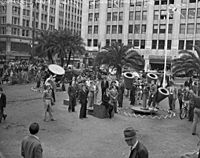
During World War II, Los Angeles grew as a center for production of aircraft, war supplies and ammunitions. Thousands of people, both blacks and whites, from the South and the Midwest migrated to the West to fill factory jobs.
After President Roosevelt issued Executive Order 9066, which authorized military commanders to exclude "any or all persons" from certain areas in the name of national defense, the Western Defense Command began ordering Japanese Americans living on the West Coast to present themselves for "evacuation" from the newly created military zones. This included many Los Angeles families.
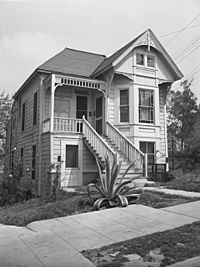
Postwar: Baby boomers
After the war, hundreds of land developers bought land cheap, subdivided it, built on it, and got rich. Real-estate development replaced oil and agriculture as Southern California's principal industry. In 1955, Walt Disney opened the world's first theme park at Disneyland in Anaheim. In 1958, Major League Baseball's Dodgers and Giants left New York City and came to Los Angeles and San Francisco, respectively. The population of California expanded dramatically, to nearly 20 million by 1970. This was the coming-of-age of the baby boom. By 1950, Los Angeles was an industrial and financial giant created by war production and migration. Los Angeles assembled more cars than any city other than Detroit, made more tires than any city but Akron, made more furniture than Grand Rapids, and stitched more clothes than any city except New York. In addition, it was the national capital for the production of motion pictures, Army and Navy training films, radio programs and, within a few years, television shows. Construction boomed as tract houses were built in ever expanding suburban communities financed by the GI Bill for veterans and the Federal Housing Administration. Popular music of the period bore titles such as "California Girls", "California Dreamin'", "San Francisco", "Do You Know the Way to San Jose?" and "Hotel California". These reflected the Californian promise of easy living in a paradisiacal climate. The surfing culture burgeoned.
Los Angeles continued to spread out, particularly with the development of the San Fernando Valley and the building of the freeways launched in the 1940s. When the local street car system went out of business, Los Angeles became a city built around the automobile, with all the social, health and political problems that this dependence produces. The famed urban sprawl of Los Angeles became a notable feature of the town, and the pace of the growth accelerated in the first decades of the 20th century. The San Fernando Valley, sometimes called "America's Suburb", became a favorite site of developers, and the city began growing past its roots downtown toward the ocean and towards the east. The immense problem with air pollution (smog) that had developed by the early 1970s also caused a backlash. With schools being closed routinely in urban areas for "smog days" when the ozone levels became too unhealthy and the hills surrounding urban areas seldom visible even within a mile, Californians were ready for changes. Over the next three decades, California enacted some of the strictest anti-smog regulations in the United States and has been a leader in encouraging nonpolluting strategies for various industries, including automobiles. For example, carpool lanes normally allow only vehicles with two/three or more occupants (whether the base number is two or three depends on what freeway you are on), but electric cars can use the lanes with only a single occupant. As a result, smog is significantly reduced from its peak, although local Air Quality Management Districts still monitor the air and generally encourage people to avoid polluting activities on hot days when smog is expected to be at its worst.
1950–2000
Beginning November 6, 1961, Los Angeles suffered three days of destructive bush fires. The Bel-Air—Brentwood and Santa Ynez fires destroyed 484 expensive homes and 21 other buildings along with 15,810 acres (64 km²) of brush in the Bel-Air, Brentwood, and Topanga Canyon neighborhoods. Most of the homes destroyed had wooden shake roofs, which not only led to their own loss but also sent firebrands up to three miles (5 km) away. Despite this, few changes were made to the building codes to prevent future losses.
The repeal of a law limiting building height and the controversial redevelopment of Bunker Hill, which destroyed a picturesque though decrepit neighborhood, ushered in the construction of a new generation of skyscrapers. Bunker Hill's 62-floor First Interstate Building (later named Aon Center) was the highest in Los Angeles when it was completed in 1973. It was surpassed by the Library Tower (now called the U.S. Bank Tower) a few blocks to the north in 1990, a 310 m (1,018 ft) building that is the tallest west of the Mississippi. Outside of Downtown, the Wilshire Corridor is lined with tall buildings, particularly near Westwood. Century City, developed on the former 20th Century Fox back lot, has become another center of high-rise construction on the Westside.
A subway system, developed and built through the 1980s as a major goal of mayor Tom Bradley, stretches from North Hollywood to Union Station and connects to light rail lines that extend to the neighboring cities of Long Beach, Norwalk, and Pasadena, among others. Also, a commuter rail system, Metrolink, has been added that stretches from nearby Ventura and Simi Valley to San Bernardino, Orange County, and Riverside. The funding of the Los Angeles County Metropolitan Transportation Authority project is funded by a half cent tax increase added in the mid-1980s, which yields $400 million every month. Although the regional transit system is growing, subway expansion was halted in the 1990s over methane gas concerns, political conflict, and construction and financing problems during Red Line Subway project, which culminated in a massive sinkhole on Hollywood Boulevard. As a result, the original subway plans have been delayed for decades as light rail systems, dedicated busways, and limited-stop "Rapid" bus routes have become the preferred means of mass transit in LA's expanding series of gridlocked, congested corridors.
Proposition 14
Since its beginning, the city was geographically divided by ethnicity. In the 1920s, Los Angeles was the location of the first restrictive covenants in real estate. By the Second World War, 95 percent of Los Angeles housing was off-limits to blacks and Asians. Minorities who had served in World War II or worked in L.A.'s defense industries returned to face increasing patterns of discrimination in housing. More and more, they found themselves excluded from the suburbs and restricted to housing in East or South Los Angeles, Watts, and Compton. Such real-estate practices severely restricted educational and economic opportunities.
In 1955, William Byron Rumford, the first African-American from Northern California to serve in the California State Legislature, introduced a fair-housing bill. In 1959, the California Legislature passed the California Fair Employment Practices Act sponsored by Augustus F. Hawkins of Los Angeles. That same year, the state's Unruh Civil Rights Act addressed fair housing but did not have any teeth. The aggrieved party had to sue to get compensation.
In 1963, California Legislature passed and Governor Pat Brown signed the Rumford Fair Housing Act which outlawed restrictive covenants and the refusal to rent or sell housing on the basis of race, ethnicity, gender, marital status, or physical disability.
In reaction to the Rumford Act, a well-funded coalition of realtors and landlords immediately began to campaign for a referendum that would amend the state Constitution to protect property owners' ability to deny minorities equal access to housing. Known as Proposition 14, it caused a storm of deep and bitter controversy across the state.
While conservatives such as Cardinal McIntyre of Los Angeles argued that blacks are "better off in Los Angeles than anywhere else", blacks knew that they were kept out of participating in the city's prosperity. On May 26, 1963, Dr. Martin Luther King, Jr. told a crowd of 35,000 at Wrigley Field, "We want to be free whether we're in Birmingham or in Los Angeles."
In November, 1964, California voters passed Proposition 14 by a wide margin.
In August, 1965, the Watts Riots broke out. Lasting six days, it left 32 dead, 1,032 injured, 3,952 arrested, $40 million in damage, and 1,000 buildings damaged or destroyed. According to later reports, the riot was a reaction to a long record of police brutality by the LAPD and other injustices suffered by blacks, including discrimination in jobs, housing, and education.
In 1966, the California State Supreme Court, in Mulkey v. Reitman, ruled that Proposition 14 violated the State Constitution's provisions for equal protection and due process.
In 1967, in Reitman v. Mulkey, the U.S. Supreme Court confirmed the decision of the California Supreme Court and ruled that Proposition 14 had violated the 14th Amendment of the United States Constitution. The federal Civil Rights Act of 1964 also addressed the issue, but made few provisions for enforcement.
The U.S. Fair Housing Act (Title VIII of the Civil Rights Act of 1968) introduced meaningful federal enforcement mechanisms.
In 1973 Los Angeles became the first major Western city to elect a black mayor with Tom Bradley.
Economic and demographic changes
The last of the automobile factories shut down in the 1990s; the tire factories and steel mills left earlier. Most of the agricultural and dairy operations that were still prospering in the 1950s have moved to outlying counties while the furniture industry has relocated to Mexico and other low-wage nations. Aerospace production has dropped significantly since the end of the Cold War or moved to states with better tax conditions, and movie producers sometimes find cheaper places to produce films, television programs and commercials. However, the film, television and music industries are still based in LA, which is home to large numbers of well-paid stars, executives and technicians. Many studios still operate in Los Angeles, such as CBS Television City at the corner of Fairfax Avenue and Beverly Boulevard and 20th Century Fox in Century City. The manufacture of clothing began on a large scale in the early 20th century. The fashion industry emerged in the 1920s with an emphasis on sportswear and leisure clothing, and expanded after 1945 to second place behind New York. Toyota opened its first overseas office in Hollywood in 1957, and sold 257 cars in the U.S. It moved operations to Torrance in 1982, because of easy access to port facilities and the LAX airport. In 2013 it sold 2.2 million vehicles in the U.S. In 2014 it announced it would move 3000 of its employees to Plano, Texas, near Dallas, to be closer to its American factories.
The ports of Los Angeles and Long Beach make up the nation's largest harbor complex, handling 44% of all goods imported by cargo container into the United States. In 2007, the equivalent of 7.85 million 40-foot shipping containers poured through the ports, with most then moving along the region's highways to massive rail yards and warehouses before heading to the nation's interior. International trade has generated hundreds of thousands of jobs in Southern California. Moving goods is now one of the largest industries in the region, one that helps provide low-cost imports to consumers across the country. The ports are among the region's most valuable economic engines.
The overall metropolitan LA economy was healthy and in just one five year boom period (1985 to 1990) attracted 400,000 working immigrants (mostly from Asia and Mexico) and about 575,000 workers from elsewhere in the U.S. The jobs they were offered depended largely on their educational qualifications. Half of the immigrants from abroad owed their employment to the immigrant economy with Asian entrepreneurs employing Latino workers. Large-scale economic changes have brought major social changes with them. While unemployment dropped in Los Angeles in the 1990s, the newly created jobs tended to be low-wage jobs filled by recent immigrants; the number of poor families increased from 36% to 43% of the population of Los Angeles County during this time. At the same time, the number of immigrants from Mexico, Central America and Latin America has made Los Angeles a "majority minority" city that will soon be majority Latino. The unemployment rate dropped from 6.9% to 6.8% in 2002, jumped during the recession of 2008, and hovered around 11-12% in 2011.
The desire for residential housing in the downtown area has led to gentrification. Historic commercial buildings have been renovated as condos (while maintaining the original outside design), and many new apartment and condominium towers and complexes are being built.
Since the 1980s, there's been an increasing gap between the rich and the poor, making Los Angeles one of the most socioeconomically divided city in the United States.
By the end of the 20th century, some of the annexed areas began to feel cut off from the political process of the megalopolis, leading to a particularly strong secession movement in the San Fernando Valley and weaker ones in San Pedro and Hollywood. The referendums to split the city were rejected by voters in November 2002.
Many communities in Los Angeles have changed their ethnic character over this period of time. For many decades, the population was predominantly white and mostly American-born until the late 20th Century. South L.A. was mostly white until the 1950s, but then became predominantly black until the 1990s, and is now mainly Latino. While the Latino community within the City of Los Angeles was once centered on the Eastside, it now extends throughout the city. The San Fernando Valley, which represented a bastion of white flight in the 1960s and provided the votes that allowed Sam Yorty to defeat the first election run by Tom Bradley, is now as ethnically diverse as the rest of the city on the other side of the Hollywood Hills.
Population history
The population of Los Angeles reached more than 100,000 with the 1900 census (Los Angeles Evening Express, October 1, 1900), more than a million in 1930, more than two million in 1960, and more than 3 million in 1990.
| Year | Population | Growth |
|---|---|---|
| 1790 | 131 | — |
| 1800 | 315 | 184 |
| 1810 | 365 | 50 |
| 1820 | 650 | 285 |
| 1830 | 1,300 | 650 |
| 1840 | 2,240 | 940 |
| 1850 | — | — |
| 1860 | 4,385 | — |
| 1870 | 5,730 | 1,345 |
| 1880 | 11,200 | 5,470 |
| 1890 | 50,400 | 39,200 |
| 1900 | 102,500 | 52,100 |
| 1910 | 319,200 | 216,700 |
| 1920 | 576,700 | 257,500 |
| 1930 | 1,238,048 | 661,348 |
| 1940 | 1,504,277 | 266,229 |
| 1950 | 1,970,358 | 466,081 |
| 1960 | 2,479,015 | 508,657 |
| 1970 | 2,816,061 | 337,046 |
| 1980 | 2,966,850 | 150,789 |
| 1990 | 3,485,398 | 518,548 |
| 2000 | 3,694,820 | 209,422 |
| 2010 | 3,792,621 | 97,801 |
| 2016 | 4,030,904 | 237,983 |
Images for kids
-
Looking north on Spring Street, 1900. The Hollenbeck Hotel is on the southwest corner of Spring and Second streets. The Bryson-Bonebrake Block is on the northwest corner. The County Courthouse is in the background.
-
Female workers taking a lunch break at the Vega aircraft plant in Burbank, California, August 1943.
-
"Fifty years ago this house at 201 N. Flower St. was offered for rental at $20 a month. Today [1946] its four apartments are bringing in $70 monthly. – LA Times, 5-7-46. This house no longer stands, and is in the approximate location of the Walt Disney Concert Hall.
See also
 In Spanish: Historia de Los Ángeles para niños
In Spanish: Historia de Los Ángeles para niños


